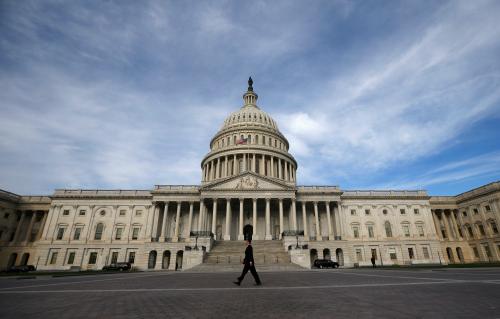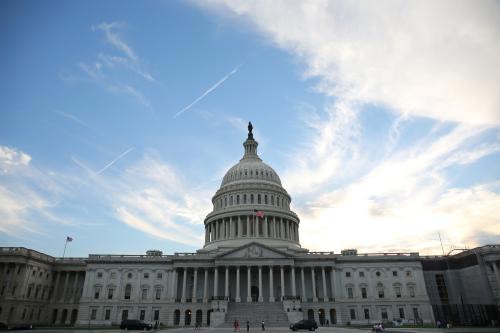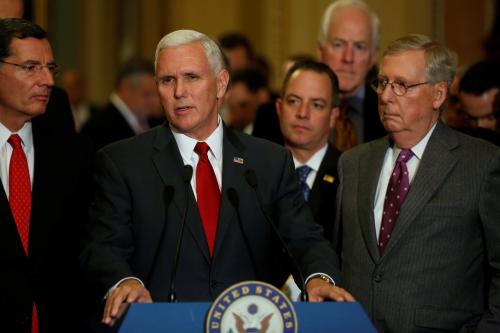Last minute changes are still being made, but Senate Republicans appear to be sticking with their plan to hold another vote this week on sweeping changes to the Affordable Care Act. Back in July, I wrote a short guide on what to watch as floor debate played out. Here’s an updated version for this latest effort, with five things to watch this week:
1. The motion to proceed
When the Senate wants to bring up a bill for consideration, it can either do so without a formal vote if all 100 senators agree, or it can vote on a motion to proceed to debate. The same will have to happen this week; Republicans will have to find at least 50 senators (with the vice president as the tie-breaking vote) willing to bring the House’s health care bill back off the calendar.
In July, McConnell chose to bring the bill to the floor with substantial uncertainty about what would happen next, creating the unusual possibility—ultimately realized—that the Senate would begin debate but the bill would ultimately fail. A repeat of that “start debate, but bill ultimately fails” experience, while possible, is probably less likely this time around. The Senate parliamentarian advised recently that procedural protections for this particular reconciliation bill expire on September 30, so Senate Republicans must act by then. Thanks to the rules of the reconciliation process, if the motion to proceed is adopted, floor consideration will proceed in a rather unusual way (see #3 and #4 below). These two factors, combined with the fact that amending a reconciliation bill on the floor is difficult to begin with, mean that it will likely be harder to convince wavering senators that they should agree to consider the bill on the grounds that it can be fixed on the floor.
2. The Byrd Bath
The Byrd Rule limits the content of bills considered through the reconciliation process. The Senate parliamentarian provides guidance on what is and is not permissible under the Rule—a process known as the “Byrd Bath”—but the parliamentarian’s determinations aren’t self-enforcing. Bill drafters must remove the offending provisions or an opposing senator must raise an objection (known as a point of order) during debate on the floor.
Given the accelerated time table on which the Graham-Cassidy proposal is headed to the Senate floor, Byrd Rule issues may not be resolved until just before the bill comes to the floor. This could affect the process in several ways. First, as long as uncertainty remains about what is actually in the bill, it is difficult for the measure’s proponents to lock down a coalition in favor of it. At the same time, the later the ambiguity around Byrd Rule issues is resolved, the less time opponents have to determine what provisions they can or should challenge on the floor.
3. Does McConnell try to request more time for debate?
What prevents a reconciliation bill from being filibustered is the limitation on the amount of time it can be debated—20 hours, per the Congressional Budget Act. All of that time was consumed in the Senate during the July debate. McConnell could, however, request more time for debate—but all 99 other senators would have to agree. Democrats, wary that additional debate time would make the proceedings seem more like “regular order,” would likely object. That, in turn, would create an opening for Republicans to accuse them of “shutting down the process.” In the end, the amount of time for debate is unlikely to affect the ultimate outcome, but conflict over it may serve as a signal for how aggressively both sides are proceeding.
4. Vote-a-rama
Because no time for debate remains on the bill, if a motion to proceed is adopted, the Senate will move immediately into what’s known as the “vote-a-rama,” or a series of continuous back-to-back amendments. There has been some discussion of a “death by vote-a-rama” strategy, whereby Democrats continue to offer amendments in order to exhaust the GOP. Even with the accelerated timetable, this would be unlikely to succeed because Republicans could likely use procedural maneuvers to end the process.
Even if McConnell is willing to use the procedural tools available to him to cut off the vote-a-rama, we may still see Democrats attempt to use the process as aggressively as they can, for two key reasons. First, the vote-a-rama is often used as a tool to make one’s partisan opponents cast difficult votes. Might Democrats, for example, offer an amendment to eliminate language regarding special deals for specific senators in order to force Republicans to vote in favor of them? Second, Democratic senators will be under significant pressure from their base to use every tool in their arsenal to try to block the bill; a highly visible floor fight would be evidence of their efforts.
5. Don’t forget the House!
If the Senate passes a reconciliation bill with a version of Graham and Cassidy’s proposal, it would then go over to the House of Representatives, as both chambers have to approve identical versions of a measure before it can go to the president for his signature. The House is unlikely to make any changes to the Senate’s bill, thanks to the aforementioned September 30 deadline for procedurally-protected consideration in the Senate. Were the House to insist on changes, it is unlikely the Senate would have time to take up before the deadline. This dynamic may well have the effect of jamming the House, forcing the lower chamber to take-or-leave whatever the upper chamber has approved. House GOP leadership has been optimistic on the bill’s chances in the House, but should it make it that far, keep a careful eye on Republicans from California and New York. Both of those states are projected to lose very substantial amounts of federal funding under the bill, and the 14 Californians and seven New Yorkers who supported the House bill in May were pivotal to its passage.
The Brookings Institution is committed to quality, independence, and impact.
We are supported by a diverse array of funders. In line with our values and policies, each Brookings publication represents the sole views of its author(s).










Commentary
What to expect when you’re expecting reconciliation bill (again)
September 25, 2017